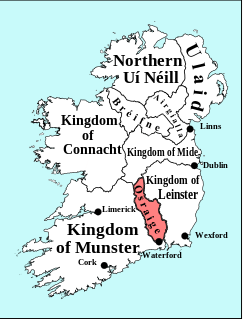Donngal mac Laidcnén (died 761) was a king of the Uí Cheinnselaig of South Leinster. He belonged to the Sil Chormaic sept of this branch of the Laigin and specifically to a branch which took over leadership of the Uí Dróna -the baronies of Idrone in modern County Carlow. His last paternal ancestor to hold the throne was his great great grandfather Crundmáel Erbuilc (died 655) [1] He ruled from 758 to 761.

Leinster is one of the Provinces of Ireland situated in the east of Ireland. It comprises the ancient Kingdoms of Mide, Osraige and Leinster. Following the 12th-century Norman invasion of Ireland, the historic fifths of Leinster and Mide gradually merged, mainly due to the impact of the Pale, which straddled both, thereby forming the present-day province of Leinster. The ancient kingdoms were shired into a number of counties for administrative and judicial purposes. In later centuries, local government legislation has seen further sub-division of the historic counties.
Crundmáel Erbuilc mac Rónáin was a King of Leinster from the Uí Cheinnselaig branch of the Laigin. He was the son of Rónán mac Colmáin, a previous king of the Sil Chormaic sept.
Contents
Donngal faced an attack by the Osraige under their king Anmchad mac Con Cherca. He suffered an initial defeat at Gowran in 759. [2] In 761 Donngal was defeated and slain at the Battle of Belach Gabraín (pass of Gowran in east-central Osraige) versus the Osraige. [3] He was succeeded by his brother Dub Calgaid mac Laidcnén (died 769). [4]

Osraige or Osraighe, Osraí, anglicized as Ossory, was a medieval Irish kingdom comprising what is now County Kilkenny and western County Laois, corresponding to the Diocese of Ossory. The home of the Osraige people, it existed from around the first century until the Norman invasion of Ireland in the 12th century. It was ruled by the Dál Birn dynasty, whose medieval descendants assumed the surname Mac Giolla Phádraig.
Anmchad mac Con Cherca was king of Osraige, a kingdom largely situated in modern County Kilkenny and western County Laois and forming part of the kingdom and province of Munster in south and south-west Ireland. Anmchad was an active ruler, who mounted repeated campaigns against his eastern neighbours in Leinster.
Dub Calgaid mac Laidcnén was a king of the Uí Cheinnselaig of South Leinster. He belonged to the Sil Chormaic sept of this branch of the Laigin and specifically to a branch which took over leadership of the Uí Dróna -the baronies of Idrone in modern County Carlow. His last paternal ancestor to hold the throne was his great great grandfather Crundmáel Erbuilc He was the brother of Donngal mac Laidcnén. He ruled from 761 to 769.
His son Cellach Tosach mac Donngaile (died 809) was also a King of Uí Cheinnselaig.
Cellach Tosach mac Donngaile was a king of the Uí Cheinnselaig of South Leinster. He belonged to the Sil Chormaic sept of this branch of the Laigin and specifically to a branch which took over leadership of the Uí Dróna -the baronies of Idrone in modern County Carlow. He was the son of Donngal mac Laidcnén and succeeded his uncle Cairpre mac Laidcnén. He ruled from 793 to 809.